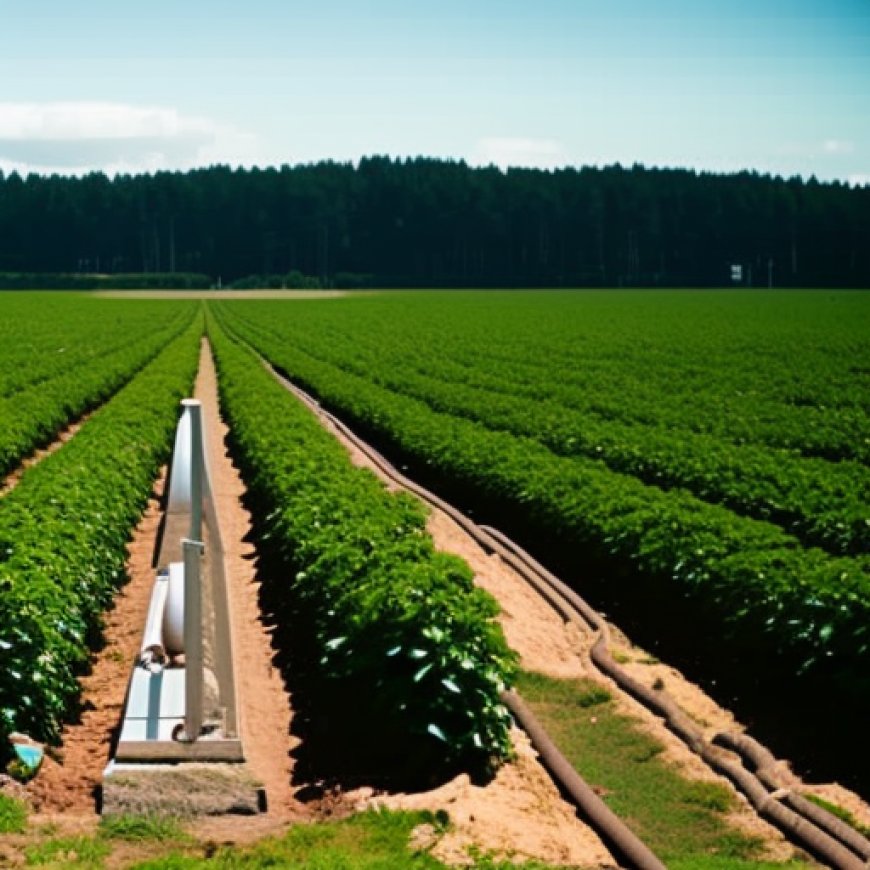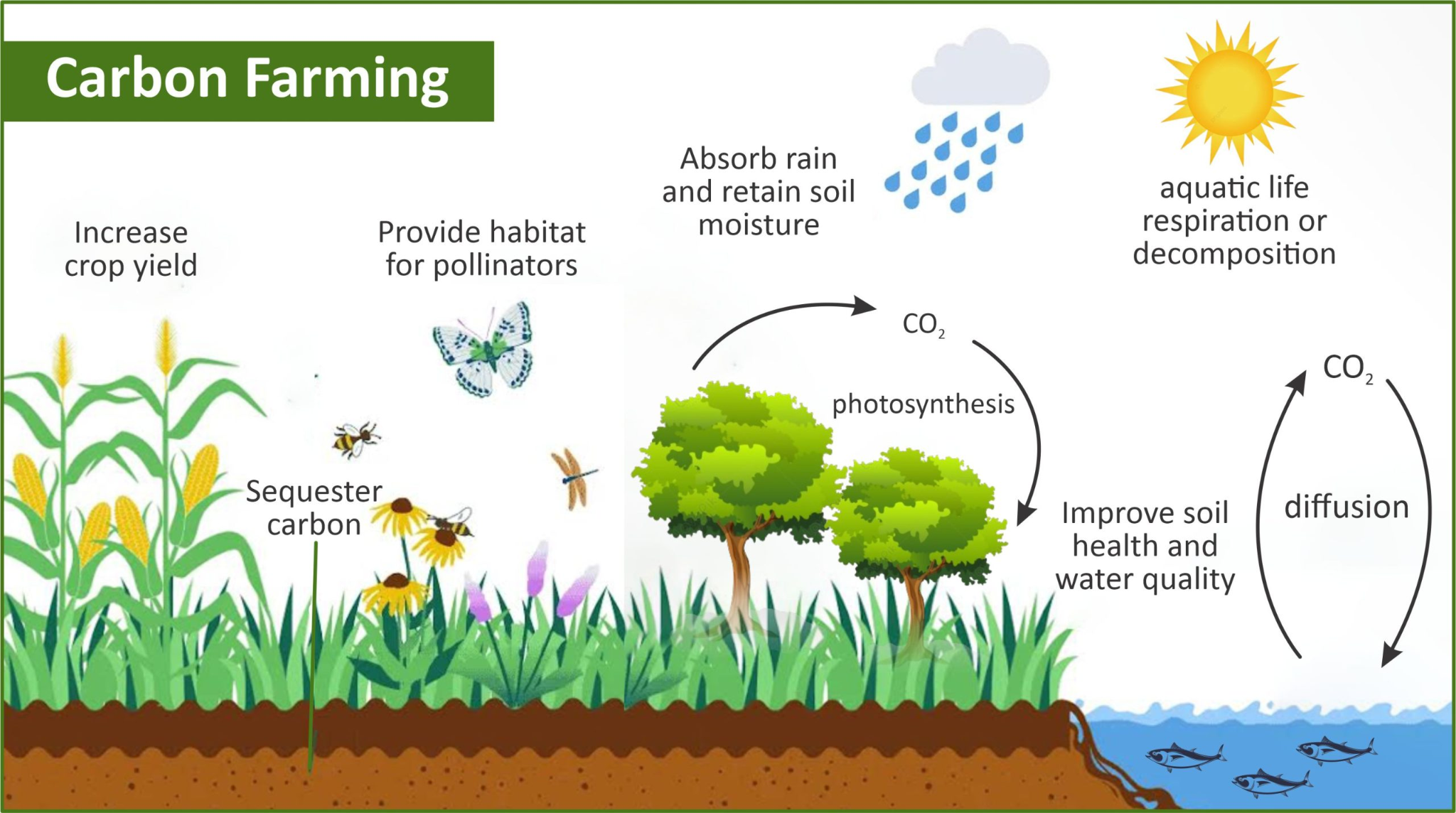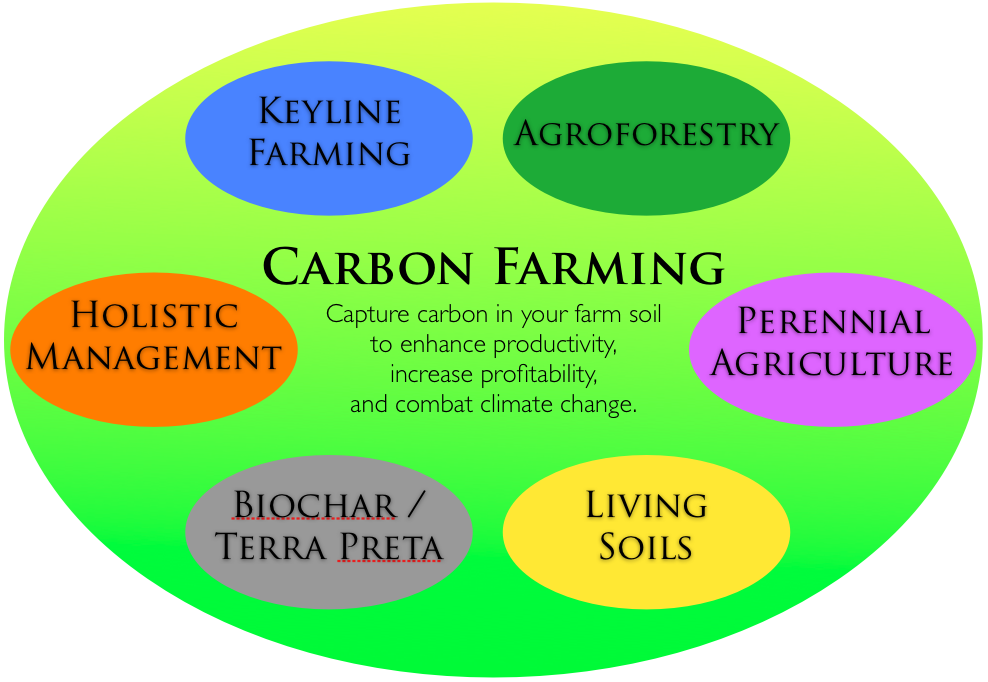Carbon Farming: A Pathway to Sustainable Agriculture
Carbon Farming: A Pathway to Sustainable Agriculture Drishti IAS


Carbon Farming: A Pathway to Sustainable Agriculture
- 11 May 2024
- 15 min read
This report is based on the article “What is carbon farming?” which was published in The Hindu on 07/05/2024. The article discusses various techniques within carbon farming that can reduce greenhouse gas emissions and the challenges in implementing such techniques, especially in developing countries like India.
For Prelims:
- Carbon farming
- Climate-resilient agriculture
- Photosynthesis
- Carbon sequestration
- Biomass
- Organic matter
- Climate change
- Net Zero goals
- Carbon credit markets
- Greenhouse gas (GHG)
- Renewable energy facilities
For Mains: Significance of Carbon Farming for Indian Agricultural Practices.
In light of escalating environmental concerns and the pressing need for climate-resilient agricultural practices, carbon farming has emerged as a crucial mechanism within the agriculture sector globally.
What is Carbon Farming?
- About:
- Carbon farming represents a strategic approach aimed at maximizing carbon sequestration and employing agricultural practices designed to enhance the absorption of carbon dioxide (CO2) from the atmosphere while facilitating its retention in both plant biomass and soil organic matter.
- This process requires careful planning, monitoring, and adaptation to local conditions to maximize its effectiveness in mitigating climate change.

What is the Significance of Carbon Farming?
- Climate Change Mitigation: Carbon farming is pivotal in the fight against climate change by sequestering carbon in soil and curbing greenhouse gas emissions.
- Soil Health Enhancement: By nurturing healthy soil, carbon farming bolsters water retention, diminishes erosion, and boosts nutrient availability, resulting in amplified crop yields and agricultural productivity.
- Converting organic waste into compost, which can be used as a soil amendment to improve soil structure, fertility, and carbon content.
- Biodiversity Enrichment: Carbon farming fosters biodiversity by fostering intricate ecosystems in agricultural settings, attracting beneficial insects and pollinators that fortify crop health and lessen dependence on pesticides.
- Economic Opportunities: Implementation of carbon farming practices opens avenues for farmers to tap into carbon credit markets, alongside potentially augmented yields from enriched soil, thus diversifying income streams and bolstering financial resilience.
What are the Techniques Involved in Carbon Farming?
- Forest Management
- Healthy forests absorb and hold carbon dioxide emissions produced from other sources and are an important source of greenhouse gas (GHG) sequestration. Carbon offsets can be created through a variety of strategies including avoiding deforestation and permanent land conservation, reforestation and replanting activities, and improved forest management.
- Agroforestry not only sequesters carbon but also provides additional sources of income for farmers and deforestation contributes to 15-20% of the rise in greenhouse gas levels globally, activities to address this include managing forests by thinning them out, selectively harvesting trees, encouraging regrowth, planting new trees, and using fertilizers to help forests grow in a productive and sustainable way.
- Grasslands Conservation
- Native grasses and other vegetation provide a natural source of greenhouse gas (GHG) absorption and sequestration.
- Carbon offsets from this category focus on maintaining native plant life through permanent land conservation and avoiding conversion for commercial development or intensive agriculture.
- Renewable Energy Production
- Renewable energy facilities such as wind or solar generate carbon offsets by displacing fossil fuel-based electricity production sources within the power grid.
- The carbon offsets derived from a certified third-party project generates the carbon credit, which is owned by the entity that develops the project.
- Conservation Agriculture Techniques
- Methods like zero tillage, crop rotation, cover cropping, and crop residue management minimize soil disruption while fostering organic matter accumulation.
- Planting cover crops during fallow periods to protect and enrich the soil, enhance biodiversity, and sequester carbon.
- Rotational Grazing
- It entails periodically relocating livestock to new pastures, this practice allows previously grazed areas to rejuvenate, minimizing erosion and fostering robust regrowth.
- The flourishing vegetation, in return, absorbs carbon dioxide from the atmosphere and sequesters it in the soil through photosynthesis.

What is the Role of Mangrove in Carbon Sequestration?
- Carbon Storage:
- Mangroves store large amounts of carbon in their above-ground biomass, below-ground roots, and organic-rich sediments.
- The dense vegetation and slow decomposition rates of organic matter in mangrove soils result in substantial carbon accumulation over time.
- Blue Carbon Ecosystem:
- Mangroves are part of the “blue carbon” ecosystem, which refers to the carbon stored in coastal and marine habitats like mangroves, seagrasses, and salt marshes.
- Despite covering less than 0.1% of the Earth’s surface, mangroves sequester and store a disproportionately high amount of carbon compared to other ecosystems.
What are the Potential Opportunities for Carbon Farming in India?
SDGs, Targets, and Indicators
SDGs Addressed in the Article:
- SDG 13: Climate Action
- SDG 15: Life on Land
Targets Identified:
- Target 13.2: Integrate climate change measures into national policies, strategies, and planning
- Target 15.3: By 2030, combat desertification, restore degraded land and soil, including land affected by desertification, drought, and floods, and strive to achieve a land degradation-neutral world
Indicators Mentioned or Implied:
- Indicator 13.2.1: Number of countries that have integrated mitigation, adaptation, impact reduction, and early warning measures into national policies, strategies, and planning
- Indicator 15.3.1: Proportion of land that is degraded over total land area
Table: SDGs, Targets, and Indicators
| SDGs | Targets | Indicators |
|---|---|---|
| SDG 13: Climate Action | Target 13.2: Integrate climate change measures into national policies, strategies, and planning | Indicator 13.2.1: Number of countries that have integrated mitigation, adaptation, impact reduction, and early warning measures into national policies, strategies, and planning |
| SDG 15: Life on Land | Target 15.3: By 2030, combat desertification, restore degraded land and soil, including land affected by desertification, drought, and floods, and strive to achieve a land degradation-neutral world | Indicator 15.3.1: Proportion of land that is degraded over total land area |
Analysis and Explanation
1. The issues highlighted in the article are related to climate-resilient agriculture practices and carbon farming, which are directly connected to SDG 13: Climate Action. The article discusses the significance of carbon farming in mitigating climate change and reducing greenhouse gas emissions.
2. Based on the article’s content, the specific targets under SDG 13 that can be identified are:
– Target 13.2: Integrate climate change measures into national policies, strategies, and planning.
– This target is relevant because the article emphasizes the need for careful planning, monitoring, and adaptation to local conditions to maximize the effectiveness of carbon farming in mitigating climate change.
3. The indicators mentioned or implied in the article that can be used to measure progress towards the identified targets are:
– Indicator 13.2.1: Number of countries that have integrated mitigation, adaptation, impact reduction, and early warning measures into national policies, strategies, and planning.
– This indicator can be used to assess the extent to which countries have incorporated climate change measures, including carbon farming practices, into their national policies and strategies.
4. The table below presents the findings from analyzing the article:
| SDGs | Targets | Indicators |
|---|---|---|
| SDG 13: Climate Action | Target 13.2: Integrate climate change measures into national policies, strategies, and planning | Indicator 13.2.1: Number of countries that have integrated mitigation, adaptation, impact reduction, and early warning measures into national policies, strategies, and planning |
| SDG 15: Life on Land | Target 15.3: By 2030, combat desertification, restore degraded land and soil, including land affected by desertification, drought, and floods, and strive to achieve a land degradation-neutral world | Indicator 15.3.1: Proportion of land that is degraded over total land area |
Overall, the article highlights the importance of carbon farming in addressing climate change and restoring degraded land, aligning with the SDGs and targets mentioned above.
Copyright: Dive into this article, curated with care by SDG Investors Inc. Our advanced AI technology searches through vast amounts of data to spotlight how we are all moving forward with the Sustainable Development Goals. While we own the rights to this content, we invite you to share it to help spread knowledge and spark action on the SDGs.
Fuente: drishtiias.com

Join us, as fellow seekers of change, on a transformative journey at https://sdgtalks.ai/welcome, where you can become a member and actively contribute to shaping a brighter future.







